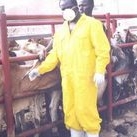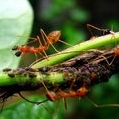NIMBioS Calendars: Events Seminars Live Streaming Visitors Working Groups Workshops Tutorials Other
2009 Archive: NIMBioS Seminars
 In conjunction with the interdisciplinary activities of the National Institute for Mathematical and Biological Synthesis (NIMBioS), a seminar series on topics in mathematical biology is hosted at NIMBioS every other Tuesday at 3:30 p.m. (unless otherwise noted) in Hallam Auditorium, Room 206, Claxton Building, 1122 Volunteer Blvd.
Seminar speakers focus on their research initiatives at the interface of mathematics and many areas of the life sciences. Light refreshments are served in the 1st floor visitor breakroom beginning 30 minutes before each talk. Faculty and students from across the UT community are welcome to join us.
In conjunction with the interdisciplinary activities of the National Institute for Mathematical and Biological Synthesis (NIMBioS), a seminar series on topics in mathematical biology is hosted at NIMBioS every other Tuesday at 3:30 p.m. (unless otherwise noted) in Hallam Auditorium, Room 206, Claxton Building, 1122 Volunteer Blvd.
Seminar speakers focus on their research initiatives at the interface of mathematics and many areas of the life sciences. Light refreshments are served in the 1st floor visitor breakroom beginning 30 minutes before each talk. Faculty and students from across the UT community are welcome to join us.
Video Archive of NIMBioS Seminars
Archived Seminar Calendars:
2020
2019
2018
2017
2016
2015
2014
2013
2012
2011
2010
2009
| Date | Speaker | Topic |
| September 2009 | ||
| 8 | Dr. Erol Akçay,NIMBioS Post-Doc. | The Evolution of Games and How to Play Them |
| 15 | Carrie Manore, Oregon State University and Los Alamos National Laboratory | How Mathematical Models Can Help Control the Spread of Animal Diseases |
| 22 | Dr. Sharon Bewick, NIMBioS Post-Doc | Modeling Local Community Responses to Climate Change |
| October 2009 | ||
| 6 | Dr. Paul Armsworth, UTK EEB | Optimal Spatial Management of Marine Fisheries - A Case Study Example. |
| 20 | Dr. Céline Devaux, Imperial College, UK | Evolution of Flowering Time and Reproductive Isolation. |
Seminar Abstracts
 Time: Tue 9/8 3:30 pm
Time: Tue 9/8 3:30 pm Speaker: Dr. Erol Akçay, NIMBioS Post-Doc
Topic:The Evolution of Games and How to Play Them
Abstract: Evolutionary game theory is one of the main theoretical tools for studying the evolution of social behaviors. In this talk, I will present two models that develop a new approach to how games and evolution are modeled. This approach explicitly and separately models both the behavioral and evolutionary dynamics of an interaction, and integrates these two. The first model treats individuals in a social interaction that are motivated by their internal objectives. The results of the interaction affect individuals’ fitness, which leads to evolutionary selection pressures on the objective functions of individuals. We show that even in a game with total conflict between individuals’ payoffs, the evolutionarily stable objectives can be such that individuals aim to increase their partner’s payoff as well as their own. In the second model, I treat the evolution of the game itself, using a population genetics model for traits that affect the payoffs in a simple, bimatrix game.
 Time: Tue 9/15 3:30 pm
Time: Tue 9/15 3:30 pm Speaker: Carrie Manore, Oregon State University and Los Alamos National Laboratory
Topic:How Mathematical Models Can Help Control the Spread of Animal Diseases
Abstract: Animal diseases, such as foot-and-mouth disease and avian flu, are increasingly important in world economics, national security, and biodiversity. Rinderpest is an important animal disease related to human measles. It is a highly virulent and often lethal virus affecting cloven-hoofed animals such as cattle, sheep, and pigs. Rinderpest pandemics have caused wide-spread herd loss in Europe and Africa. If the disease enters the United States, it could be devastating to animal agriculture and the economy. To help prepare for this possibility, we create a spatially explicit stochastic model for multi-host animal diseases to better understand their spread in the United States. We explore the effectiveness of mitigation strategies such as quarantine, vaccination, and culling in a case study on rinderpest. Spread of rinderpest is modeled using county-level data and animal transportation rates to capture the within-county and between-county behavior. We compare different mitigation strategies and analyze the sensitivity of final epidemic size to these strategies in order to minimize loss due to an outbreak of rinderpest. Generalizations of control strategies for rinderpest are effective for other contagious animal diseases, such as foot and mouth disease.
 Time: Tue 9/22 3:30 pm
Time: Tue 9/22 3:30 pm Speaker: Dr. Sharon Bewick, NIMBioS Post-Doc
Topic:Modeling Local Community Responses to Climate Change
Abstract: I will be talking about the development of a mechanistic mathematical framework that models both competitive and mutualistic interspecific interactions with the goal of interpreting community dynamics and altered community structure under a warming regime. In particular, I will focus on climatic change as it affects ant communities in the temperate forests of eastern North America. To that end, the primary interspecific interactions that I will be discussing will relate to competition between ants for food resources. Previous models have considered competitive interactions between ants in terms of dominance-discovery tradeoffs. Certainly, global climate change may perturb both the dominance relationships between species and/or the discovery abilities of individual species, and this may have predictable consequences on community composition. More recently, however, several empirical studies have suggested that a dominance-thermal tolerance tradeoff may be more important than a dominance-discovery tradeoff, at least in the temperate forests of eastern North America. With this tradeoff, the impact of global climate change is even more obvious. I will therefore discuss the development of mechanistic mathematical models that capture the features of dominance-thermal tolerance tradeoffs and the possibility of using these models to predict community composition, both under current climatic conditions and under a warming regime. Finally, I will briefly touch on aspects related to modeling the impact that the ant community has on the plant community through ant-plant seed dispersal mutualisms.
 Time: Tue 10/6 3:30 pm
Time: Tue 10/6 3:30 pm Speaker: Dr. Paul Armsworth, UTK EEB
Topic:Optimal Spatial Management of Marine Fisheries - A Case Study Example
Abstract: Technological advances and improvements in our understanding of the life history of marine species make increasingly precise spatial management possible in many fisheries. Spatial management strategies are often recommended as ways to manage bycatch in fisheries and fisheries that threaten particularly sensitive life history stages, like spawning. We examine a case study that illustrates when such management measures can be justified on ecological and economic grounds. Specifically, we examine whether these measures present an economically efficient means to protect Atlantic bluefin tuna (Thunnus thynnus) on their western Atlantic spawning ground. Longline fishermen targeting yellowfin tuna (T. albacares) catch spawning bluefin as bycatch in the Gulf of Mexico, an area where bluefin are supposed to be protected. We combine a behavioral model of bluefin migration with population dynamic models for the two species and an economic representation of relevant fisheries. Time-area closures are predicted to be economically costly if there is little scope for recovery of the bluefin stock. However, such closures can be economically efficient if integrated into long-term management plans to rebuild the bluefin population. This difference reflects changes to the relative profitability of the fisheries involved. Whether a closure is optimal depends on the productivity of a rebuilt bluefin population, the discount rate, and the costs of forgone fishing opportunities.
 Time: Tue 10/20 3:30 pm
Time: Tue 10/20 3:30 pm Speaker: Dr. Céline Devaux, Imperial College, UK
Topic:Evolution of Flowering Time and Reproductive Isolation
Abstract: This study investigates reproductive isolation in time within and among species, and changes in flowering phenologies. Quantitative genetic models of flowering time allow an examination of early and late stages of speciation, and predict changes in the population and individual flowering phenologies in different ecological scenarios. Application of these models to the sympatric speciation of palm trees on Lord Howe Island is then discussed.
NIMBioS Seminar Calendar (Feb - Mar, 2009)
| Date | Speaker | Topic |
| February 2009 | ||
| Thu 2/19 11:00-12:00 M307 Walters Life Science |
Degui Zhi, Dept. Plant and Microbial Biology, UC Berkeley. | Protein structural comparison, classification, and function prediction in the structural genomics era. |
| Tue 2/24 1:30-2:30 307 Nielsen Physics |
Jaewook Joo, Computational Systems Biology Dept., Sandia National Laboratories. | A poor man's explanation of noise-induced cellular response in single cells. |
| Thu 2/26 10:15-11:15 511 Buehler |
Rongsong Liu, Dept. Mathematics, Purdue Univ. | Plant-herbivore interactions mediated by plant toxicity. |
| Fri 2/27 10:00-11:30 205 Claxton |
Jian Ma, Center for Biomolecular Science and Engineering, UC Santa Cruz. | Reconstructing the evolutionary history of mammalian genomes. |
| March 2009 | ||
| Mon 3/2 10:00-11:00 156/157 Plant Biotech Bldg. |
Linda Highfield, Dept. Veterinary Integrative Biosciences, Texas A&M Univ. | The Potential Role of Wildlife in the Spread and Control of Foot and Mouth Disease in an Extensive Livestock Management System |
| Mon 3/2 1:00-2:30 511 Buehler |
Liang Liu, Dept. Organismic and Evolutionary Biology, Harvard Univ. | Estimating species phylogenies under the coalescence model |
| Wed 3/4 12:00-1:30 511 Buehler |
Brian O'Meara, National Evolutionary Synthesis Center. | Developing and applying tools to answer outstanding biological questions using phylogenies |
| Wed 3/4 3:30-5:00 A-118 VTH (Voss Veterinary Teaching Hospital) |
Seyed Moghadas, Institute for Biodiagnostics, National Research Council, Canada. | Dynamics of resistance emergence in influenza infection with compensatory mutations |
| Mon 3/9 11:00-12:00 M311 Walters Life Science |
Hong Qin, Dept. Agricultural & Environmental Science, Tuskegee Univ. | Studying yeast aging through natural variation, statistical inference and mathematical modeling |
|
Mon 3/9 1:30-2:30 A-118 VTH (Voss Veterinary Teaching Hospital) |
Paul Torgerson, Ross Univ. School of Veterinary Medicine. | Echinococcus, math and public health. A complex conundrum or just plain common sense? |
| Mon 3/9 3:35-4:35 102 Haslam Business Bldg. |
Shigui Ruan, Dept. Mathematics, Univ. of Miami. | Nonlinear dynamics in structured epidemic models |
| Thu 3/12 2:15-3:15 307 Science & Engineering |
Vitaly Ganusov, Los Alamos National Laboratory. | Modeling CD8 T cell dynamics following acute infections of mice |
| Thu 3/12 3:30-4:30 M309 Walters Life Science |
David Liberles, Dept. Molecular Biology, Univ. Wyoming, Laramie. | Gene duplication, positive selection, & the evolution of gene function |
| Wed 3/25 1:30-3:00 M307 Walters Life Science |
Jian Liu, Dept. Molecular and Cell Biology, UC Berkeley. | Mechanochemical feedbacks of cellular processes |
NIMBioS
1122 Volunteer Blvd., Suite 106
University of Tennessee
Knoxville,
TN 37996-3410
PH: (865) 974-9334
FAX: (865) 974-9461
Contact NIMBioS


